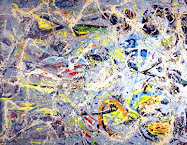 Do take the time to follow Susan Abbott's A Painter's Year. Usually in Vermont, this watercolorist is touring the Pacific Northwest right now and is live-blogging by posting her paintings. Today's Seattle image, Seattle Street Corner, hits the nail on the head.
Do take the time to follow Susan Abbott's A Painter's Year. Usually in Vermont, this watercolorist is touring the Pacific Northwest right now and is live-blogging by posting her paintings. Today's Seattle image, Seattle Street Corner, hits the nail on the head.
Did I mention it rains there?gif by i karen
Smack Down the Axe
In the comments section of my recent post, Red Tree, a good conversation took place about the role of the artist as self-critic. In the post, I said:
"A thing I do is, after completing a run of artworks, I will spot a couple of dogs in the lot, and axe those. Then, I will look at the remainder, and axe the two or three weakest paintings, as well."
Here is the conversation.
Carolyn L. asks:
"While you are 'axing' what questions do you ask yourself? What do you look for? Do you have a specific set of guidelines you apply? While I am sure the process is not entirely objective, there must be a thought process you pursue. Learning to evaluate one's own work is not easy. It is not a skill directly taught in art class. I would like to hear your take on the subject."
My response:
Good questions, Carolyn.
Sure, the first thought is something subjective. A niggling something that isn't right (usually a compositional problem). Often, the compositional issue has to do with proportion. Some element is too big, or too small.
The big problem is when it's close to okay, and then the struggle starts.
Distance of a day helps. I sit and look at my work a lot. I tape or tack the series on the wall and stare and evaluate. I use mats or tape to frame them. I get the rejects out of the way, although they still reside on the wall somewhere out of the way. A stack of rejects (or 2 or 3 stacks) sit around the studio, and I can refer to those for ideas later.
No guidelines. That's a little too static for me.
I look for strength in a painting.
I don't outright reject a work for technique issues. Some mistakes are okay with me if the point comes across. And, meanwhile, I am on a program to improve my technique! There's a contradiction there for you.
Some very important reasons for rejecting an artwork are if they don't fit the series, or my style direction. In that vein, I will get rid of works that have too many sharp or defined edges, or too much detail, compared to the whole.
Another issue can be dull spots where the paper just packed up too much with pastel.
Another problem can be value comparisons. Bad value progressions - too stark or too similar, are a bad thing.
Maybe a shape of an element isn't right. Too regular; wrong size or direction.
Endless...and people think art is easy!
Diane Wenzel then followed up with this question:
"Casey, your review of critical axing is very useful. But how is it when you begin a series? When you are in the heat of creation, what do you do with your critical hacking voice? If the hacker is asleep, I can see how you might become caught up in one place adding unwanted, useless details."
Me:
Well, Diane, it sounds like you are asking two questions. One: how to edit a whole series at the start. The other: do I get caught up in a the process and add superfluous stuff?
Or, perhaps you are asking that if the series is in its infancy, how can I tell which parts belong?
I never choose a series from an idea. The series presents itself based on a successful image that needs to be explored many times. So, the series is already a successful image and hopefully never contrived.
What are the qualities of that first successful image (or two)? These become my criteria. Also, my whole art statement comes into play (color - modern treatment - realism - abstract heavy).
Superfluous stuff? I go down that road often. That's why I have to edit the works after they are done. Interestingly, I will be in the groove and create nice works with new and fresh passages, and all is well then. Other times, I won't even know what I am doing in the studio!
Abstract Expressionism, Art Criticism, Artists, Colorist Art, Drawing, History, Impressionism, Modern Art, Painting, Pastel, Post Impressionism


















